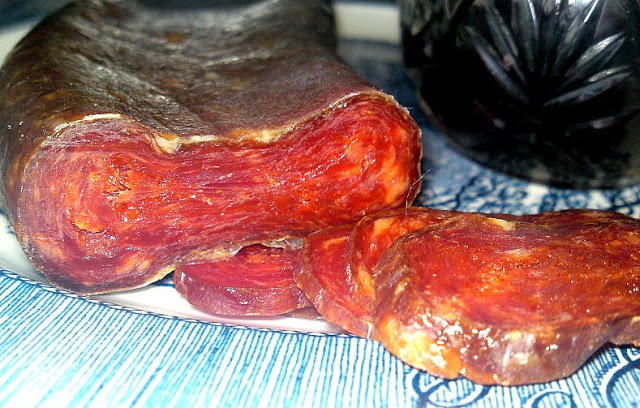A number of years ago I crossed paths with one of the BEST cured sausages I've ever had. I like the firm texture of cured salami and this one takes the cake for flavor, firmness, and overall enjoyment of eating!
After some poking around I found the creator who lives in NY. Well, the guy who makes it is a butcher/processor and I got it from his girlfriend. They've both been making this product for years and keep a supply on hand for special events, holidays, and gifts. It's that good! This is the recipe they provided and as much as I want to try making my own batch, I have safety concerns over the salt/meat ratio and humidity of a regular refrigerator. I'd love thoughts and opinions from experts here...especially any tweaks you'd make to the salt and curing process.
Ingredients *NOTE* Amounts for each ingredient were 'guesstimates' only
(30# batch)
Leanest pork (they use cushion butts)
Table salt - 1 1/2 Cups
Fennel Seed - 1/2 Cup
Crushed Red Pepper - 1 Cup
Paprika (color) - 1/2 Cup
Grind to burger, mix well and stuff tightly into hog casings (~5" links or so they fit whichever size canning jars you use).
Use a hat pin and poke into an fresh orange (often) and poke lots of holes in the casings to allow moisture out.
Hang in refrigerator for 2 weeks, keeping the door closed as much as possible.
Pack links into medium canning jars tightly and fill to top with corn oil. (30# will fill 14-15 canning jars)
The longer you let them set, the better.
To eat, wipe off oil or rinse with cold water and slice. As you remove sausages from a jar, add oil to keep them completely covered in corn oil.
Again, these links are to die for. Does anyone see any red flags?
After some poking around I found the creator who lives in NY. Well, the guy who makes it is a butcher/processor and I got it from his girlfriend. They've both been making this product for years and keep a supply on hand for special events, holidays, and gifts. It's that good! This is the recipe they provided and as much as I want to try making my own batch, I have safety concerns over the salt/meat ratio and humidity of a regular refrigerator. I'd love thoughts and opinions from experts here...especially any tweaks you'd make to the salt and curing process.
Ingredients *NOTE* Amounts for each ingredient were 'guesstimates' only
(30# batch)
Leanest pork (they use cushion butts)
Table salt - 1 1/2 Cups
Fennel Seed - 1/2 Cup
Crushed Red Pepper - 1 Cup
Paprika (color) - 1/2 Cup
Grind to burger, mix well and stuff tightly into hog casings (~5" links or so they fit whichever size canning jars you use).
Use a hat pin and poke into an fresh orange (often) and poke lots of holes in the casings to allow moisture out.
Hang in refrigerator for 2 weeks, keeping the door closed as much as possible.
Pack links into medium canning jars tightly and fill to top with corn oil. (30# will fill 14-15 canning jars)
The longer you let them set, the better.
To eat, wipe off oil or rinse with cold water and slice. As you remove sausages from a jar, add oil to keep them completely covered in corn oil.
Again, these links are to die for. Does anyone see any red flags?
Last edited:






